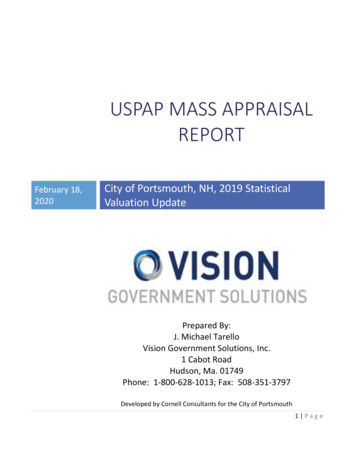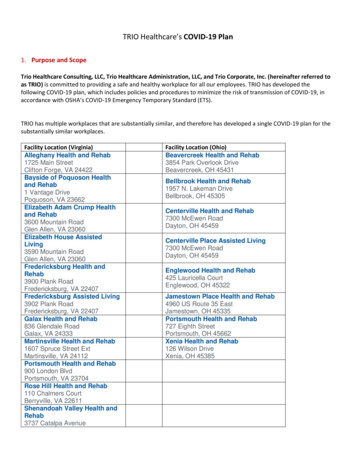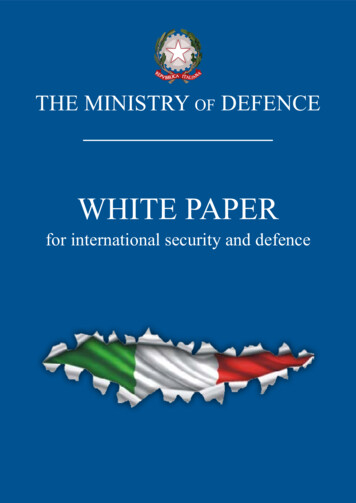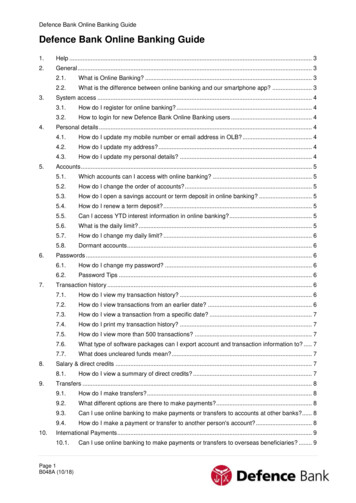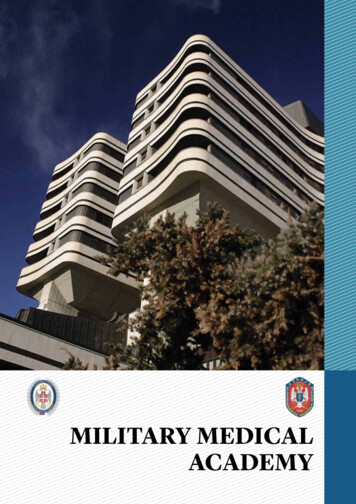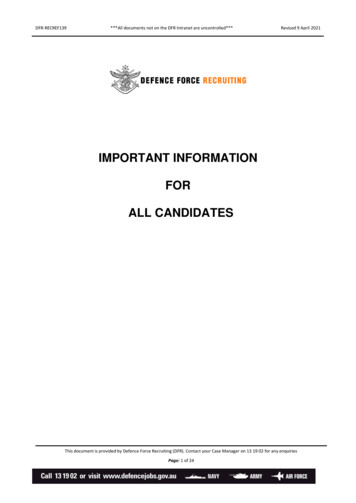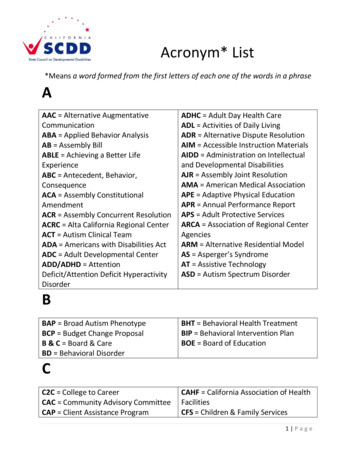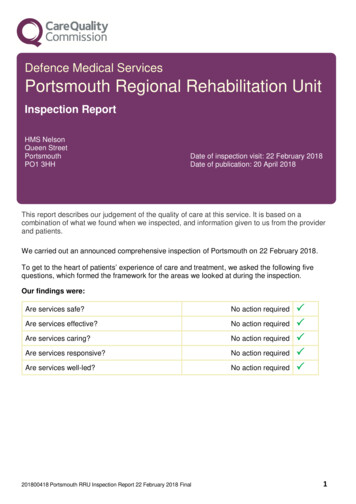
Transcription
Defence Medical ServicesPortsmouth Regional Rehabilitation UnitInspection ReportHMS NelsonQueen StreetPortsmouthPO1 3HHDate of inspection visit: 22 February 2018Date of publication: 20 April 2018This report describes our judgement of the quality of care at this service. It is based on acombination of what we found when we inspected, and information given to us from the providerand patients.We carried out an announced comprehensive inspection of Portsmouth on 22 February 2018.To get to the heart of patients’ experience of care and treatment, we asked the following fivequestions, which formed the framework for the areas we looked at during the inspection.Our findings were:Are services safe?No action requiredAre services effective?No action requiredAre services caring?No action requiredAre services responsive?No action requiredAre services well-led?No action required201800418 Portsmouth RRU Inspection Report 22 February 2018 Final 1
Summary of findingsOverall summaryLetter from the Chief Inspector of HospitalsWe carried out an announced comprehensive inspection at Portsmouth Regional RehabilitationUnit (RRU) on 22 February 2018.Defence Medical Services is not subject to the Health and Social Care Act 2008 and is not subjectto the CQC’s enforcement powers. The CQC undertook this inspection as an independent body.We do not have a legal duty to rate but we have highlighted good practice and maderecommendations on issues that the service could improve.Our key findings across all the areas we inspected were as follows: There was an open and transparent approach to patient safety and a system in place forreporting and recording significant events.Systems and processes to keep patients safe were embedded at the unit. Staff understoodtheir responsibilities to raise concerns, to record safety incidents, concerns and near misses,and to report them internally and externally.There was evidence of some quality improvement in the service provided. There was a qualityimprovement plan identified which was in line with the strategy. This included planned serviceimprovements together with improvements, which had been suggested by staff and patients.However, due to increased turnover of staff this was not embedded. The team had recognisedthis as a focus for the coming months now they were established.Patients were positive about their interactions with staff and said they had been treated withcompassion.Staff were aware of current evidence-based guidance.Staff had received the mandatory training required to provide them with the skills andknowledge to deliver safe care and treatment.The training compliance at the time of inspection was at 100%.Results from the patient feedback showed patients were treated with compassion, dignity andrespect and were involved in their care and decisions about their treatment.Information about services and how to complain was available.The unit was equipped to treat patients and meet their needs however, the facilities did impacton the service’s abilities to provide confidential treatment sessions.There was a clear leadership structure and staff felt supported by management.We identified the following notable practice, which had a positive impact on patientexperience:201800418 Portsmouth RRU Inspection Report 22 February 2018 Final2
There were effective systems for reporting and recording incidents. Staff understood theirresponsibilities to raise concerns, to record safety incidents, concerns and near misses, and toreport them internally and externally.There was a strong team approach to multidisciplinary working between the exerciserehabilitation instructor (ERI) and Physio team. This included the assessment and treatment ofpatients and reviewing each other’s practice.Clear actions had been taken to improve access to podiatry, following delays due to a vacancy.The service had received approval to recruit a locum podiatrist during the recruitment processof the permanent podiatrist but this has not been filled because of a lack of applicants.Staff showed an encouraging, sensitive and supportive attitude to people who used servicesand understood and respected people’s personal and social needs.Evidence based practice was used to guide treatment and there was a strong culture ofcontinuous improvement. Staff were aware of current evidence based guidance and practicewas reviewed through detailed clinical audit and service evaluation.Management in the unit demonstrated they had the experience, capacity and capability to runthe service and ensure high quality care.There was a clear leadership structure and staff felt supported by management.Recommendations for improvementWe found the following areas where the service could make improvements: Staff seeing patients in the Multidisciplinary Injury Assessment Clinic (MIAC) did not alwaysundertake the five moments of hand hygiene. All staff should follow hand hygiene guidance.Privacy and confidentiality for patients could be improved. We observed treatment, progressand end of course discussions being held in the gym area, which was being used by otherpatients, other MoD staff attending the PT gym and contract staff carrying out roofing repairs.We are aware staff always checked patients were happy to commence treatment andconversations in the gym area however, we would suggest a review of the situation, as it is notbest practice.A rolling programme of clinical improvement work should be embedded to ensure that the bestoutcomes possible are achieved for patients.Staff should be aware of the standard operating procedure to formalise the process for whenthere was a problem with the pool and it was out of use.Professor Ted BakerChief Inspector of Hospitals201800418 Portsmouth RRU Inspection Report 22 February 2018 Final3
Regional Rehabilitation Unit PortsmouthDetailed findingsWhy we carried out this inspectionThe Care Quality Commission (CQC) carried out this inspection as one of a programme ofinspections at the invitation of the Surgeon General in his role as the Defence Authority forhealthcare and medical operational capability. Defence Medical Services (DMS) are not requiredto register with CQC under the Health and Social Care Act (2008) (Regulated Activities)Regulations 2014. Consequently, DMS services are not subject to inspection by CQC and CQChas no powers of enforcement. However, where CQC finds shortfalls in the quality of servicesduring inspection, we will report them by making a recommendation for action to the SurgeonGeneral’s office.Background to the serviceRegional Rehabilitation Unit (RRU) Portsmouth is a facility provided by the Defence PrimaryHealthcare (DPHC) Unit delivering intermediate rehabilitation within the Defence MedicalRehabilitation Programme (DMRP). It is located at HMS Nelson in Portsmouth and providesclinical management of moderate musculoskeletal conditions to the military population within adefined geographical area. There are 15 RRUs across the United Kingdom.RRU Portsmouth serves a population at risk (PAR) of 15,280 personnel broken down as follows: HMS Nelson – 6,000 personnelHMS Excellent – 1,300 personnelThorney Island – 1,200 personnelHMS Collingwood – 2,000 personnelHMS Sultan – 2,000 personnelSouthwick Park – 1,000 personnelMarchwood – 580 personnelRM Poole – 1,200 personnelAdditionally, care is provided to patients on home sick leave and reservists that reside in theregion.Access to the service is through referral from other services in the DMRP and patients receive aninitial joint assessment by a doctor (a specialist GP trained in sports and exercise medicine) and aclinical specialist physiotherapist, in the Multidisciplinary Injury Assessment Clinic (MIAC) locatedat the RRU. Patients can access one to one treatment and rehabilitation courses to treat theirconditions. Courses generally run for three weeks and are condition specific. (On occasions,course content could be compressed to two weeks to accommodate RRU staff leave.) Patients areexpected to attend for the duration of the course and can live on site or off-site locally. During201800418 Portsmouth RRU Inspection Report 22 February 2018 Final4
courses, patients can access one to one treatment at the same time.The RRU is staffed by a service lead, a clinical specialist physiotherapy lead, physiotherapists, adoctor, lead exercise rehabilitation instructor (ERI), ERIs and administrators. At the time ofinspection, the service had a vacancy for a full time band 7 podiatrist and a part time (16 hours)MIAC doctor.Facilities include four treatment rooms, two gym areas, one containing fitness and strengthequipment and one large shared gym area, a classroom/group treatment room and access to theswimming pool on site. The large gym area was shared with the naval base physical trainingdepartment.The Defence Medical Services (DMS) are not registered with the CQC under the Health andSocial Care Act (2008) (Regulated Activities) Regulations 2014 and are not required to be.Consequently, DMS services are not subject of regulatory inspection by CQC and CQC has nopowers of enforcement. This inspection is one of a programme of inspections that CQC willcomplete at the invitation of the Surgeon General in his role as the Defence Authority forhealthcare and medical operational capability.We carried out a comprehensive announced inspection of this service. RRU Portsmouth has notbeen inspected by CQC previously.Our inspection teamOur inspection team was led by a CQC inspector. The team included a CQC Inspector and a CQCInspection Manager. The team were joined by two Defence Medical Services (DMS) SpecialistAdvisor in Rehabilitation and a representative of the DMS.How we carried out this inspectionBefore visiting, we reviewed a range of information about the unit. We carried out an announcedinspection on 22 February 2018. During the inspection, we: Spoke with a range of staff, including physiotherapists, exercise rehabilitation instructors(ERIs), administrators, service lead, and doctor. We were able to speak with patients whowere on courses or receiving treatment on the day of the inspection.Looked at information the service used to deliver care and treatment.Reviewed patient notes, complaints and incident information.To get to the heart of patients’ experiences of care and treatment, we always ask the following fivequestions: Is it safe?Is it effective?Is it caring?Is it responsive to people’s needs?Is it well-led?What people who use the unit sayPatient survey results were reviewed for new patients attending three courses at the service from4 December 2017 to 15 December 2017. The results showed the unit was performing in line with201800418 Portsmouth RRU Inspection Report 22 February 2018 Final5
other RRUs. All 32 survey forms distributed were returned. This represented 100% of the patientstreated at the unit in the last course. 88% of patients said they would recommend this facility. 91% of patients felt people listened to their comments, compliments and complaints. 91% of patients said they felt involved in decisions regarding their care.As part of our inspection, we also spoke with 10 patients. All were positive about the standard ofcare received and thought staff were approachable, committed and caring. Patients said they hadbeen given the tools to manage their condition and their own rehabilitation. Staff were ‘superhelpful’ they ‘knew their stuff’. Staff ensured patients fully understood their own treatmentprogrammes and took time to discuss any issues or concerns they had with completing theirprogrammes.201800418 Portsmouth RRU Inspection Report 22 February 2018 Final6
Detailed findingsAre services safe?Our findingsWe found that this practice was safe in accordance with CQC's inspection frameworkThe shortcomings did not have a significant impact on the safety and quality of clinical care.Safe track record and learningThere was a system for reporting and recording significant events. Staff understood their responsibilities to raise concerns, to record safety incidents, concernsand near misses, and to report them internally and externally. There was a system forreporting and recording significant events. Staff knew how to report incidents using theelectronic system and were confident to do so. Once reported, the incident would bereviewed by the service lead who had responsibility for investigating and responding to theincident.During the reporting period February 2017 to January 2018, 17 incidents had been reported.Senior staff had reviewed all incidents, themes were identified and appropriate action hadbeen taken to minimise further occurrences. We reviewed three incident files at the time ofthe inspection. These included an injury to a patient during recreational therapy, a delay inorthotic provision and an incomplete injection log. In all cases, incidents were investigatedand the cause identified together with actions to reduce further risk.Staff were all aware of the clinical incidents that had occurred in the service andimprovements made in response to them. There was a thorough understanding of thebalance between safety and challenging patients to progress their rehabilitation. This meanttreatments were delivered safely, while not limiting the opportunity for patients to progress.Patients involved in incidents were not always kept fully informed during the incident reviewprocess. There was not a formal process for feeding back to patients about any changes inpractice following incident investigation once patients had been discharged.The incident recording form supported the recording of notifiable incidents under the duty ofcandour. (The duty of candour is a set of specific legal requirements that registeredproviders of services must follow when things go wrong with care and treatment). Thismeant principles of duty of candour had been followed including being open, honest andoffering an apology to the patient as soon as the incident had been identified, irrespective ofwho was to blame. In incidents we reviewed, an apology had been given.Lessons were learned and shared, and action taken as a result of investigations. Incidents,investigations, actions and learning were discussed at team meetings. Staff told us if an201800418 Portsmouth RRU Inspection Report 22 February 2018 Final7
incident had happened, it was discussed as a team and no blame was placed on theindividual. The team reviewed actions and learning to reduce the likelihood of the incidenthappening again, and provided support to each other to achieve this.Staff described how their practice had changed as a result of an incident and how the teamhad worked together to learn, take action and reduce the risk in the future.Updates and learning from significant incidents which had happened at other RegionalRehabilitation Units (RRU) was available to staff on the intranet update page and ifappropriate, discussed at staff meetings. Staff told us about learning which had been sharedfrom other units.Overview of safety systems and processesThe unit had clearly defined and embedded systems, processes and units in place to minimiserisks to patient safety Arrangements for safeguarding reflected relevant legislation and local requirements.Policies were accessible to all staff. The policies clearly outlined whom to contact for furtherguidance if staff had concerns about a patient’s welfare.All staff were trained to safeguarding level two, this was in line with the national guidance(intercollegiate document, 2014) which recommends staff should be trained to one of fivelevels of competency, depending upon role and interaction with adults and children. Staffinterviewed demonstrated they understood their responsibilities regarding safeguarding andhad received training relevant to their role.At the time of inspection, the service did not have a lead member of staff for safeguarding.The trained staff member had left the service in December 2017. A staff member to take onthe lead role had been identified however, due to a lack of local courses running; they hadnot been trained to the required level. This had been identified on the service’s risk registerand actions had been taken to mitigate the risk. Staff had access to an appropriately trainedstaff member in medical department in the adjacent building. This allowed staff directaccess to an appropriate member of staff while patients were in the department beingtreated.Staff had a programme of mandatory training in safety systems, processes and practices.The compliance level for the service was set at 100%. Levels of compliance were recordedon an electronic system. We saw records, which showed all training had been carried out byall eligible staff. Mandatory training included healthcare governance awareness, officesafety, unconscious bias, security general threat brief, and safeguarding children level two.Resuscitation equipment was available in the department and at the swimming pool. Anautomatic external defibrillator (AED) was available and easily accessible in the poolsideoffice and in the gym. A resuscitation bag the necessary equipment to deliver basic lifesupport, was located in the MIAC clinic area. It was located in the treatment room, whichhad a keypad lock on the door, this could delay access by a few seconds.Items such as pocket masks, first aid kits, eyewash bottles and emergency blankets werealso available on both gym and pool sites. Checks carried out on the first aid kits and AEDidentified equipment was in date. Records confirmed checks on the equipment took placeeach day the clinic was open.A qualified lifeguard was on duty at the swimming pool when patients were receivingtreatment to protect both patients and staff. The lifeguard on duty would support the staff inthe event of an emergency. There was a clear accident and emergency procedure availablefor staff working in the pool area, located on the wall next to the emergency call bell andtelephone by the pool. The bell alerted other staff to provide assistance and the telephoneenabled the emergency to be reported to the naval base emergency services. There wasaccess to buoy’s (floating device) and throw bags at various points around the pool to help201800418 Portsmouth RRU Inspection Report 22 February 2018 Final8
anyone who may be in distress or required assistance. There was also access to evacuationboards to recover people from the pool who had a suspected spinal injury.The swimming pool was checked four times daily to maintain the correct chlorine levels andpH balance, ensuring the pool was safe for use. Staff from the RRU were not responsible forthese checks, and did not have access to the test register to ensure regular testing hadbeen carried out. If there was a problem with the pool and it was out of use, staff told ussomeone from the swimming pool would make RRU staff aware in advance of any sessionsbeing carried out. Staff were unaware of any standard operating procedure document heldby the RRU to formalise this procedure. The pool had not been out of use during thereporting period.There was access to fluid spill kits (a cleaning kit to clear up any bodily fluid spillages) tosafely manage any bodily fluid spillage and the risk of cross infection. Staff had access tokits for blood spillages, urine and vomit in the event of a situation occurring. Each of the kitshad been checked and were in date.A comprehensive risk assessment had been completed for risks concerning the swimmingpool, with identified risks being managed positively. Five risks had been identified. Theseincluded medical problems associated with exercise, drowning, exacerbation of symptoms,slips, trips and falls and infection. Each risk identified the control measures, a risk rating anda named person with oversight of the risk. The risk assessment had been completed inSeptember 2017 and was due for a review in September 2018.Individual care records were written and managed in a way, which kept people safe. Patientrecords were electronic and could be accessed on computers around the department. Allelectronic patient records were password protected and access was limited to staff withauthorisation to view them. The system provided an audit trail of every member of staff whohad accessed or amended patient records.A policy was available for staff identifying the Caldicott principals and how they should beapplied. Caldicott principals are the seven confidentiality principals, which outline howpersonal confidential data should be stored. The service lead overseeing the RRU was theCaldicott lead for the unit. Information about the Caldicott principals was available to staffaround the department identifying the principals and their responsibilities. There had beenno audits carried out at the RRU to identify compliance with the principals.Patient records were organised, up to date and shared and stored appropriately. Wereviewed a combination of 10 patient records from the multidisciplinary injury assessmentclinic (MIAC) and rehabilitation courses. Records included referral information, patientassessments, consent, treatment plans, goals, outcome measures pre and post treatmentand were all complete. We were told emotional and psychological screening was notroutinely carried out unless a concern was picked up by a member of the team at the MIACclinic. Issues of this nature would usually be identified at the patient’s primary carerehabilitation unit and addressed.Notes audits were completed annually and included five sets of records comprised the initialassessment and a follow up for each clinical area of the Regional Rehabilitation Unit (RRU).Clinical areas included MIAC, lower limb, spines, hip and groin courses and podiatry.Compliance was measured against eight areas. These included mandatory compliance,subjective assessment, objective examination, analysis, treatment planning, treatmentimplementation, transfer of care and documentation. The target for compliance was 75%. Arecords audit had been completed in April 2017; however, actions arising from the audit hadnot been implemented into practice. All but one area of the RRU was compliant with the75% target. The MIAC and spines course achieved 77%, the lower limb course achieved79%, the hip and groin course achieved 81% whilst the podiatry clinic demonstrated 65%compliance. One consistent omission from patient records across all areas on the RRU wasthe lack of evidence about the patient’s perception of their needs. There were fiverecommendations following the audit. These included one for the MIAC team, one for the201800418 Portsmouth RRU Inspection Report 22 February 2018 Final9
course team, two for podiatry and one to debrief all staff regarding the audit findings. Wewere told due to the challenges the RRU had faced with regards to staffing, therecommendations from this audit had not been implemented into practice and staff had notbeen de-briefed regarding the outcome of the audit. A re-audit was due to be completed inApril 2018. Now the staffing situation had improved and a request had been made to employa podiatrist we were told recommendations following the next audit would be actioned andassurance gained to ensure new recommendations were embedded into practice.Chaperones were available if required. Notices advising on availability and how to accesschaperones were on display in the waiting areas and in treatment areas throughout theservice. Staff who acted as chaperones were trained for the role and had received aDisclosure and Barring Service (DBS) check. DBS checks identify whether a person has acriminal record or is on an official list of people barred from working in roles where they mayhave contact with children or adults who may be vulnerable.The unit maintained appropriate standards of cleanliness and hygiene. We observed thepremises to be clean and tidy. There were cleaning schedules and monitoring systems inplace. Standards of cleanliness and hygiene were maintained at the pool and theenvironment was free from clutter. The environment was visibly clean and all equipmentwas safely stored off the floor and in designated areas to ensure safety of patients and staffin the pool area.The unit flight lieutenant was the infection prevention and control (IPC) clinical lead who wasbased in the department full time. Staff could approach them to discuss any issues aroundinfection prevention and control. There was an IPC protocol and staff had received up todate training. Annual IPC audits were undertaken and we saw evidence that action wastaken to address any improvements identified as a result.Most staff we observed in clinic undertook the five moments of hand hygiene and were barebelow the elbows. However, we did observe staff seeing patients in the MIAC clinic did notalways undertake the five moments of hand hygiene. Staff uniforms appeared clean andtidy.Equipment was cleaned before and after patient use. Equipment covers and chairs in thedepartment were covered in wipe-able fabric to allow them to be cleaned between patientuses. All chairs and equipment were in good condition.The maintenance and use of equipment kept people safe. A policy was in place forequipment care and staff knew where to find it and what it contained. Staff were clear on thefrequency which equipment should be reviewed and serviced and a system was in place tocheck equipment using a 373 form. We reviewed the file of 373 forms, which showedgenerally checks had been completed on all equipment. Staff where aware when forms hadnot been completed as per policy and followed these up so they could be assured checkshad taken place for all equipment.Issues with equipment were reported verbally to the appropriate person on site. Thisresulted in the equipment being labelled and being put out of use out of use and a service orrepair was booked. Staff felt equipment was repaired and made fit for use quickly. Thisprocess was documented on the appropriate spreadsheet.Most gym equipment had stickers attached, which identified the date when it had last beenserviced. This allowed staff to visually check equipment before use to make sure it was safeto use. Equipment that did not have completed stickers on was however, recorded aschecked on the equipment service log. Therefore, we were assured the equipment hadbeen serviced.Gym equipment was in good condition and working order throughout the department. Whennot in use, equipment was stored away and off the floor in suitable storage shelving.The arrangements for managing medicines, including emergency medicines in the unit,minimised risks to patient safety (including obtaining, prescribing, recording, handling,storing, security and disposal). There was a medicines management policy available and201800418 Portsmouth RRU Inspection Report 22 February 2018 Final10
staff participating in the obtaining, storing, handling, prescribing, supplying and disposing ofmedicines were suitably trained and their competency assessed. In the reporting period,February 2017 to January 2018 there had been no medicines incidents reported by staff.Appropriate recruitment checks had been undertaken prior to employment. For example,proof of identification, evidence of satisfactory conduct in previous employments in the formof references, qualifications, registration with the appropriate professional body and theappropriate checks through DBSMonitoring risks to patientsThere were procedures for assessing, monitoring and managing risks to patient and staff safety. There was a health and safety policy available to all staff on the intranet.The unit had an up to date fire risk assessment and carried out regular fire drills. There weredesignated fire marshals within the unit. There was a fire evacuation plan, which identifiedhow staff could support patients with mobility problems to vacate the premises.There were systems in place for testing and maintenance of medical equipment. Allelectrical and clinical equipment was checked and calibrated to ensure it was safe to useand was in good working order. There were effective systems in place regarding the storageof clinical items. All items in the clinic room checked, such as disposable cleaning cloths,syringes, dressings, saline and bandage were in date. There was a record kept when itemshad been opened.Risks to people who used services were assessed and their safety monitored andmaintained. Staffing levels, skill mix and caseloads were planned and reviewed to ensurepeople received safe care and treatment at all times, in line with relevant tools andguidance. Actual staffing levels did not meet the planned staffing levels for the service.Staffing levels for the service were set at twelve whole time equivalent (WTE) staff toinclude four clinical civilian staff (two physiotherapists, a podiatrist, and a doctor), twoadministrators, one flight lieutenant, one leading hand, one petty officer, one chief pettyofficer physical training (CPOPT) and one military major (Maj) who was the service lead anda physiotherapist. In the reporting period February 2017 and January 2018, the actualstaffing level for the service was at 90.5%. The service had one vacancy for a podiatrist (24hours per week) since April 2017 and a vacancy for a MIAC doctor (17.5 hours per week)since January 2018. RRU Portsmouth had received approval to recruit a locum podiatristduring the recruitment process of the permanent podiatrist but this has not been filledbecause of a lack of applicants. The Major, a physiotherapist and CPOPT, an exerciserehabilitation instructor (ERI), both worked clinically and would cover staff absences in thedepartment by carrying out assessments and running groups. All staff told us they wouldstep in to support sessions in times of staff shortage.Arrangements to deal with emergencies and major incidentsThe service had adequate arrangements to respond to emergencies and major incidents. All sta
201800418 Portsmouth RRU Inspection Report 22 February 2018 Final 2 Letter from the Chief Inspector of Hospitals We carried out an announced comprehensive inspection at Portsmouth Regional Rehabilitation Unit (RRU) on 22 February 2018. Defence Medical Services is not subject to the Health and Social Care Act 2008 and is not subject
